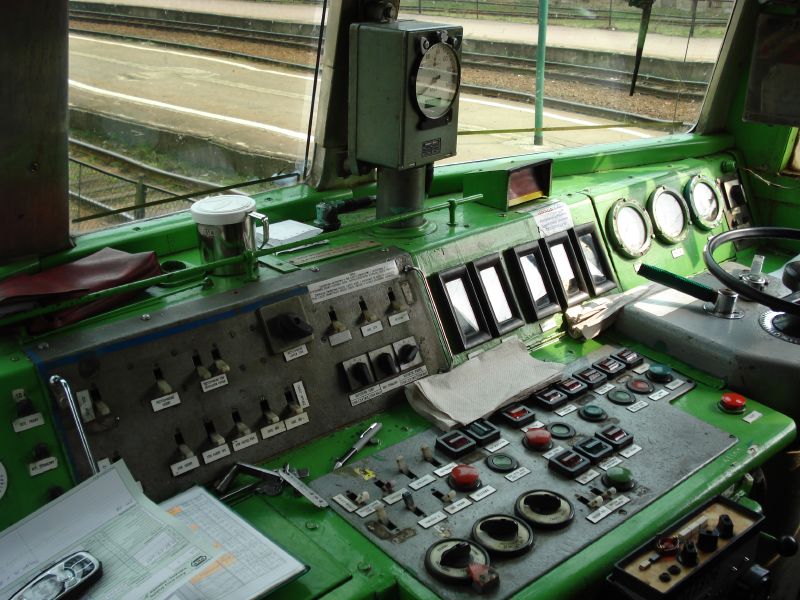- PKP class EU07
Infobox Locomotive Auto
name = EU07
powertype = Electric
caption = EU07-004 locomotive inGliwice 
caption2 = Driver's desk of an EU07.
builder =Pafawag Wrocław
Cegielski
serialnumber =
buildmodel = 4E (Pafawag )
303E (Cegielski)
builddate =1965 -1994
totalproduction = 483
whytetype =
aarwheels =
uicclass = Bo'Bo'
gauge = RailGauge|sg
leadingsize =
driversize = 1,250 mm
trailingsize =
wheelbase =
length = 15,915 mm
width = 3,038 mm
height = 4,343 mm
framesize =
weightondrivers = 20 t
weight = 80 t
locotenderweight =
fueltype =
fuelc
tenderc
consumption =
watercons =
electricsystem = 3,000 V DC
collectionmethod = pantograph
primemover =
enginetype = EE 541B
aspiration =
displacement =
boiler =
boilerpressure =
feedwaterheater =
firearea =
tubearea =
fluearea =
tubesandflues =
fireboxarea =
totalsurface =
superheatertype =
superheaterarea =
cylindercount =
cylindersize =
rearcylindersize =
hpcylindersize =
lpcylindersize =
valvegear =
transmission = 79:18
topspeed = 125 km/h
poweroutput = 2,000 kW
tractiveeffort = 280 kN
factorofadhesion =
locobrakes = Oerlikon
trainbrakes =
railroad =PKP
railroadclass = EU07
numinclass =
roadnumber =
officialname =
nicknames = Siódemka
Anglik
locale =
deliverydate =1965
firstrundate =
lastrundate =
retiredate =
restoredate =
scrapdate =
currentowner =
disposition =|EU07 is the name for a Polish
electric locomotive in service of the Polish railway operator "PKP ". This locomotive was designed as universal locomotive, and as such is used in both for freight and passenger traffic.Technical data
EU 07 have driving cabins on both ends of the box. The locomotive is equipped with multiple working device which allows a single driver to drive two coupled engines from one cabin. This engine is able to pull passenger trains of up to 650 t. weight with speed of 125 km/h and freight trains of up to 2000 t. weight with speed of 70 km/h. These figures apply to driving on horizontal railway lines.
History
The EU07 is strongly connected with the
EU06 locomotive. The EU06 was a British derivative of the Class 83 locomotive built for the Polish system. In1959 an agreement was signed with the producer of theEU06 ,English Electric , under which Poland bought the license for theEU06 and started its production inPafawag Wrocław , under build number "4E". The first item was finished in1965 , and by1974 a total number of 240 locomotives had been built. The EU07 locomotives only differed slightly from EU06 thanks to some minor improvements that had been made with comparison to their predecessors.In
1983 the production of EU07 locomotives was re-opened in Cegielski works inPoznań . This new series of locomotives was based on ET41 freight locomotive (which had been built by joining two EU07 locomotives of first run production). Bringing several modifications production number changed to "303E". A total number of 243 items were built and the production continued until1994 despite this engine was out of date then.Further innovations
EP07 is a later modification of EU07. Modification has been made in several Rolling Stock Repairing Works since1995 . EP07 locomotives change only class name, but not the serial number.Nicknames
*Siódemka ("The Seven") - from the number
*Anglik ("The Englishman") - refers to the English origins of EU07 - English-built EU06'sResources
# [http://www.igor.kolej.szczecin.pl Modern Locos Gallery]
# [http://www.rail.pl Rail Service]
# [http://www.mikoleje.kolej.szczecin.pl Mikoleje]
# [http://www.parowozy.pl/skansen Chabówka Rail Museum]
# [http://www.kolej.pl/szczurek/ EU07 - Kolejowe Dzieło Sztuki] (en: "EU07 - Railway Masterpiece"), URL accessed on June 06,2007 ee also
*
Polish locomotives designation
Wikimedia Foundation. 2010.
